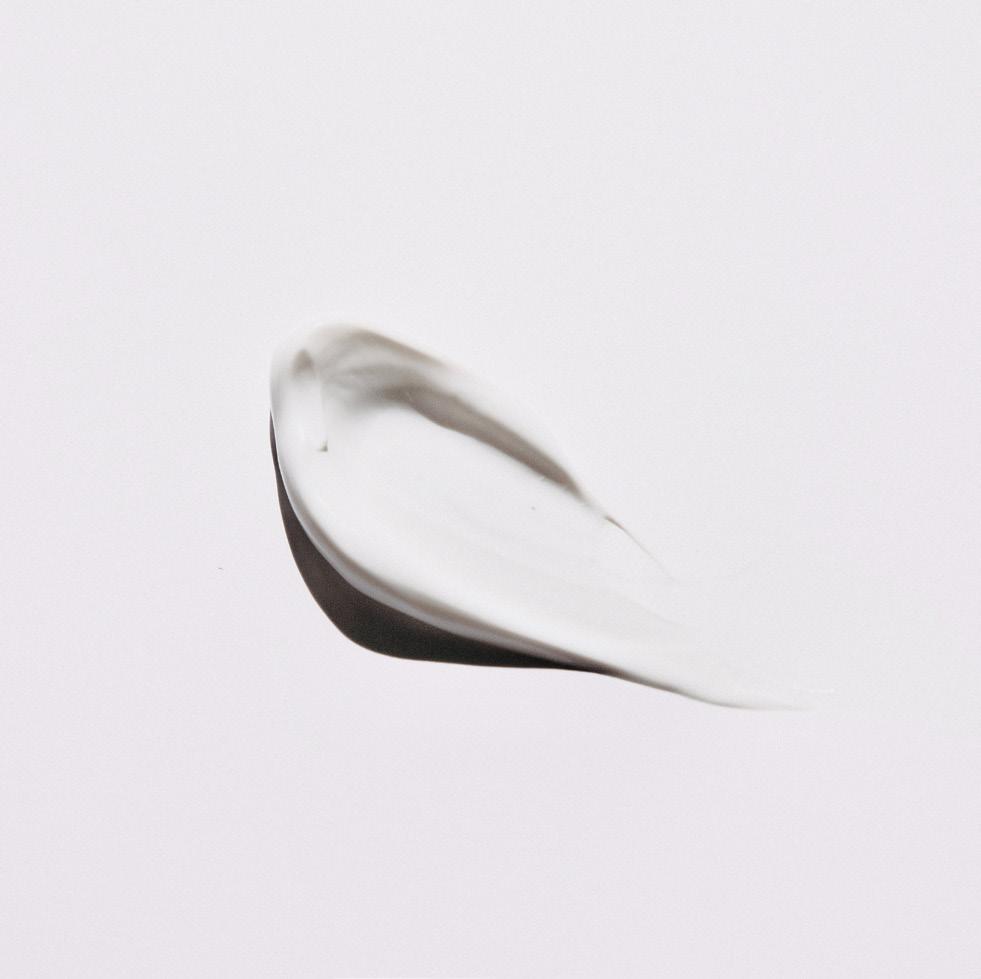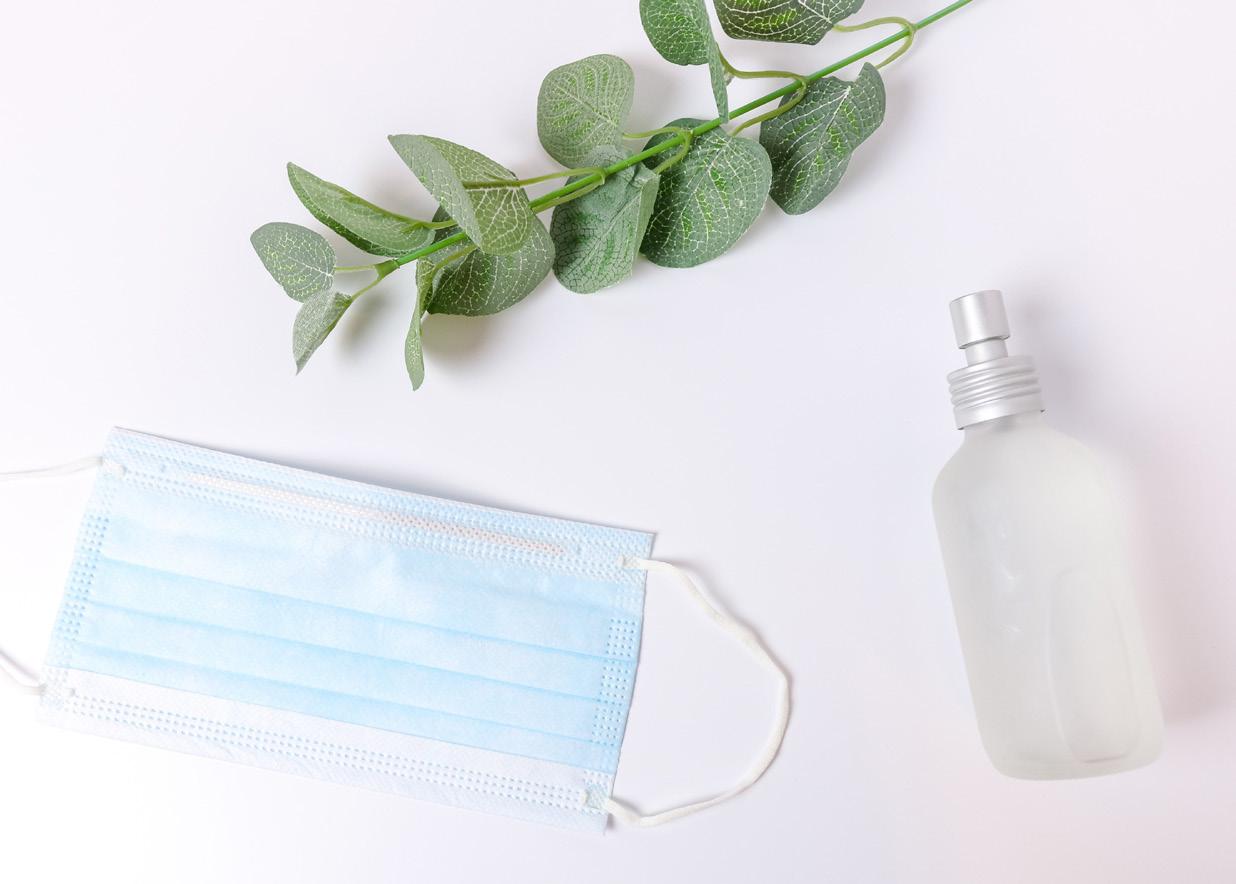
10 minute read
Getting the Upper Hand in Skincare
BY NANCY ROMO | DESIGN BY KATERA LEE
We have been through a lot of changes in the past several months. A long time from now, we will look back and remember measures like mask-wearing, social distancing, and a lot of hand washing. While trying to minimize COVID-19 infection, the risk for another condition — eczema — has increased. Although quarantine may have challenged our well-being, we shouldn’t have to disregard one health aspect for another. This article will explore what I wish I knew about skin care before the pandemic and what we should know about eczema as we all look forward to a healthier future.
Advertisement

The Situation
To understand how eczema affects the skin, we should first familiarize ourselves with the basics of our skin. The skin is an organ with many purposes, and can be broken down into three main layers: the epidermis, the dermis, and the hypodermis.
The epidermis is the outermost layer and it acts as the main “barrier” of the skin. The epidermis has a tightly-bound “brick-and-mortar” cell structure, fulfilling a purpose similar to that of the walls of a house: keeping the external substances out while regulating the internal environment. The keratinocytes that make up the epidermal “walls” are shed and replaced regularly (usually each month), and are not as likely to be infected as interior cells. Substances that do manage to pass through this layer are identified by the Langerhan cells, which attach to the invading substances and alert the immune system of their presence.
As the densest layer of the skin, the dermis makes up most of the skin’s thickness and maintains many of its functions. With its vast vessel system, the dermis allows for the transportation of nutrient-rich red blood cells throughout the body as well as the transportation of white blood cells through the lymphatic vessels to fight off infections. The dermis also includes our sweat glands and hair follicles, which help regulate our body temperature through sweat evaporating and cooling off our skin.
The hypodermis, also known as the subcutaneous or fatty layer, acts as an insulator to the body and preserves heat.
Now that we’ve had a crash course about the skin’s biology, we can describe how eczema challenges the skin.

What is Eczema?
Eczema, also known as atopic dermatitis, is characterized by inflammation (redness) and/or irritation of the skin.
It is further labeled as either “irritant contact” dermatitis (such as with a foreign substance to the skin) or allergy-related dermatitis—both of which cause our defensive immune system to act up.
Symptoms include visible redness and the emergence of a web-like skin pattern on the back of the hands that eventually forms into dry, cracked regions. This scientific description is exactly what I experienced, down to the webbing pattern. For me and many others, this irritation was exacerbated by excessive hand washing, unaccompanied by proper skin care.
As a matter of fact, a study by researchers of the British Journal of Dermatology revealed that after the initial COVID-19 impact of March 2020, 40% of Danish children developed hand eczema after returning to school. Although the study is limited to Denmark, people around the world (including myself) could relate to this trend. But what actually causes eczema, and how have the COVID-19 precautions further exacerbated it?
The exact cause of eczema is unknown, but there are many factors that may trigger it.
1. Irritation: As mentioned before, the outermost epidermal layer tries to block out pathogens (i.e. viruses, bacteria, and fungi) while retaining moisture. People with eczema reveal “loosened up” tissue in the outermost epidermis layer, allowing substances to more-readily penetrate the skin. Once infiltrated, the skin’s immune system responds swiftly to get rid of the invaders, triggering inflammatory symptoms such as redness, swelling, blister formation, scaling, and roughness.
Frequent hand washing is classified as an irritation, since prolonged washing causes swelling of the outermost skin layer and increases the skin’s sensitivity to physical and chemical irritants.
2. Dehydration: It is no surprise that dehydration can cause dryness of the skin: low hydration means lower skin moisture and thus, a weaker epidermal barrier.
3. Overhydration: A less-obvious suspect, overhydration by sweat trapped while wearing gloves for long periods of time can also lead to eczema. Like taking a longer-than-necessary bath, exposing the skin to extreme temperature and environmental conditions can affect its natural composition.
4. Environment: The exposure to new settings (i.e. changes in the environment due to traveling) leads to the development of another potential change to the skin’s structure. Our immediate environment (eg. a sauna or hot shower) or local environment (eg. living in a dryer region) causes our skin and immune system to adapt to certain settings, so the skin reacts when the setting changes.

Eczema and COVID-19
Generally, damaged skin brings upon more viruses and diseases than healthy skin. Washing damaged skin is less effective for disease prevention than washing healthy skin since viruses like the infamous SARS-CoV-2 can more-readily enter the skin’s blood vessels and make its way throughout the body. With higher vulnerability to diseases, over-washing defeats the very purpose of hand hygiene, which is why awareness of skin hygiene is important.
Reading all of these potential causes can be discouraging, but fortunately there are just as many possible resolutions.
The Solution
After getting more familiar with the causes and nature of eczema, we can discuss ways to combat it and take some weight off of our immune systems. Let’s look at some examples and learn how each of them can promote healthy practices.
1. Soaps
When we think of soap, we might think of cleanliness. Soap is a fundamental cleaning staple since it has both hydrophilic (water-“loving”) and hydrophobic (water-repelling) properties, allowing for the mixing of water and oil. Building a lather (from rubbing your hands together) allows the soap to attach to hydrophobic oil, grease, or debris; then, rinsing away with water washes debris all away thanks to soap’s hydrophilic property. When buying soap, watch out for the words “perfume” or “fragrance” in the ingredients list, since they may introduce more irritants into the skin than necessary.
Make sure to look for “hydrating” or “moisturizing” hand soaps. After developing eczema, I was advised by my primary care provider to use such hand soaps, and I have experienced smoother skin ever since.
2. Moisturizers
A moisturizer is any product that replenishes the skin from feeling dry. Moisturizers typically have a 50:50 water-to-oil ratio, meant to create a hydrating skin barrier and relieve severely dry skin.9 Vegetable oils (coconut oil, olive oil, etc.) and products such as skin jellies are inexpensive and easily accessible alternatives.
3. Lotions
Lotions are a type of moisturizer meant to relieve dry, ashy skin. Lotions have a higher water content than moisturizers and feel “lighter” on the skin. Due to its lower viscosity, lotion is more readily-absorbed by the skin and is suitable for daytime use since it feels less greasy than moisturizers while still sealing in moisture.10
There are also different types of lotions for different parts of the body. I like to use face-specific lotion, which is even thinner than body lotion, and lowers how much product build-up feels on my face while still fulfilling its purpose.

4. Hand Sanitizers
Hand sanitizers serve to rid our hands of germs and bacteria. Although hand washing is the best way to remove all types of germs and chemicals, hand sanitizers with at least 60% alcohol work to immediately get rid of germs and contamination, especially when you’re on the go. Sanitizers come in different types, including ethanol-based and alcohol-based. Of the two, ethanol tends to be less irritating than pure alcohol without sacrificing effectiveness.
As a tip, when applying hand sanitizers, remember to rub it thoroughly over your hands and fingers until dry to prevent germ transmission during application.
5. Disposable paper towels
Regarding hand drying, the best product to use is a disposable paper towel, since traditional cloth towels can accumulate bacteria with each use.
Try to be thoughtful of how much paper towels you use! You can refer to the “shake-and-fold” method when drying hands: shaking wet hands 12 times to get rid of excess water, then using one folded paper towel to dry your hands.
6. Gloves
Gloves physically prevent the skin from exposure to chemicals and other substances. People with hand eczema should look for “latex-free” gloves since latex can be allergy-inducing and irritate the skin. Nitrile gloves, made of latex-free synthetic rubber, protect against most chemicals and infectious agents. Rubber gloves are the next-best option, since they still protect against mildly-corrosive products such as bleach.

Practices to Preventing Eczema
Now that we have the knowledge, let’s discuss what we should—and shouldn’t—do for our skin.
Do...
...Wash and dry your hands gently and softly. Patting your hands dry rather than harshly rubbing them will lower risk of skin abrasion.
...Moisturize your hands at night. A healthy bedtime routine to adopt is to moisturize your hands so they have time to absorb the benefits overnight.
...Moisturize your hands whenever they are exposed to a substance or an activity. This includes after hand washing, hand sanitizing, or wearing gloves for a long time throughout the day when convenient. To keep your hands refreshed after washing your hands, apply moisturizer while they are still slightly damp with a fragrance-free, light moisturizer or cream. I personally don’t like my hands feeling slippery since I write a lot of notes, but light moisturizers or lotions that dry quickly are in my favor for both my hands and face. Moisturizer should also be applied after putting on hand sanitizer, once it has been rubbed in and the skin is dry. Contrary to what you may think, moisturizers do not make the sanitizing less effective!
...Eat foods rich in essential fatty acids or supplement your body with them. Fish, nuts, seeds, and plant oils are all examples of foods rich in fatty acids, which have natural anti-inflammatory properties which can help the body fight off disease.
Do not…
...Wear rings or jewelry for long periods of time, since they can trap soap and chemicals beneath them and congest the skin.
...Take too many long baths in a short time span. It is recommended to take around 5-minute showers that are warm, not hot, since excessive heat dries out the skin. Time-wise, dermatologist Dr. Anderson claims that no more than 30 minutes of a week should be devoted to bathing.
Conclusion
If you think you may be developing hand eczema, seek a dermatologist’s advice either in person or through telehealth appointments. The statistics regarding global health can seem grim at times, but fortunately we have the power to take care of ourselves and our skin.
We’ve had a lot on our hands for a while; it’s time we start catering to them.

References
1. “The Dynamics of the Skin’s Immune System.” U.S. National Library of Medicine. (2019).
2. “Layers of the Skin.” National Cancer Institute. (n.d.).
3. “The skin is an immune organ.” U.S. National Library of Medicine. (1994).
4. “High incidence of hand eczema in Danish schoolchildren following intensive hand hygiene during the COVID-19 pandemic: a nationwide questionnaire study.” Wiley Online Library. (2020).
5. “Hand Hygiene Practices and Risk and Prevention of Hand Eczema during the COVID-19 Pandemic.” U.S. National Library of Medicine. (2020).
6. “Hand hygiene and skin health.” Journal of Hospital Infection. (2003).
7. “How Does Soap Work?” Hackensack Meridian Health. (2020).
8. “How to make sure a product is really fragrance-free.” Best Health Magazine. (2014).
9. “Moisturizer vs Lotion: What’s the Difference & Which Should You Use?” Epiphany Dermatology. (2016).
10. “Moisturizing 101: Cream vs Lotion.” Hutton Klein Dermatology. (n.d.).
11. “How to use a paper towel.” TED Conferences. (2012).
12. “Dry Skin, Eczema and How To Treat It [Dermatology].” Colorado Dermatology Institute. (2018).










